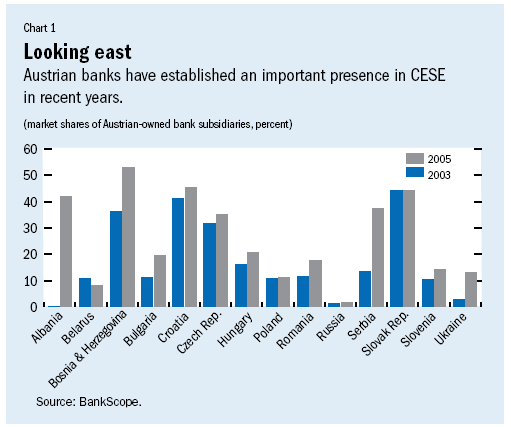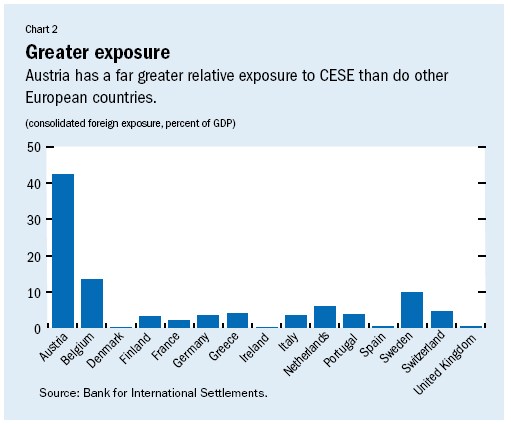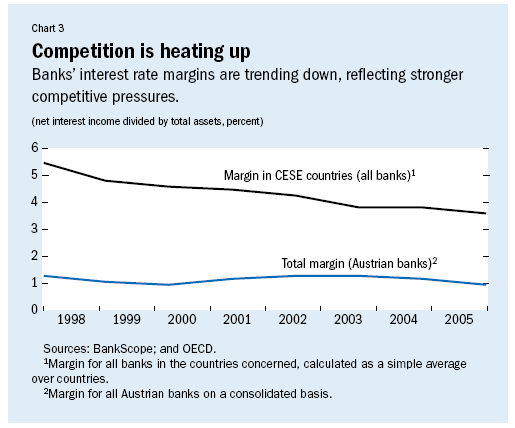
Typical street scene in Santa Ana, El Salvador. (Photo: iStock)
IMF Survey: Austria's Banks Expand Eastward
June 18, 2007
- Austria's banks have expanded into central, eastern, southeastern Europe
- Greater exposure must be matched by stronger supervision, risk management
- In particular, growth in foreign exchange lending requires close monitoring
Austria's economy is doing well, and one of the building blocks of its economic success is the banking sector, which has been expanding rapidly in central, eastern, and southeastern Europe (CESE).

Shopping precinct in Vienna, Austria, where banks have expanded rapidly into central, eastern, southeastern Europe (photo: Kiefer/SIPA)
EUROPEAN BANKING
This process has been highly profitable and has helped financial deepening in the region. It is, however, not without risk. Therefore, it needs to be accompanied by a strong focus on risk management by the banks and effective cross-border cooperation between supervisors in Austria and CESE.
Economic growth in Austria has consistently exceeded that in the euro area in recent years, and unemployment has declined. A number of factors help explain Austria's success. The government's macroeconomic policies have ensured stability, structural reforms have improved the functioning of the economy, and a social partnership has helped keep wages in check.
In addition, Austria's private sector has sought out new business opportunities in fast-growing markets located in CESE. Austria's growing relations with the countries in this region are based not only on increased trade and investment but also on stronger financial ties, made possible by the expansion of Austrian banks.
A bit of history
Driven by geographical proximity, historical ties, and a saturated domestic market, Austrian banks were among the first to enter the new markets in central and eastern Europe in the early 1990s. During 2003-05, they gained market share in almost all of the CESE countries (see Chart 1). Today, they are active in virtually all countries in the region.

Even though Austrian banks are not large by international standards, their subsidiaries are large in relation to the size of the economies in CESE. These subsidiaries have also become important to Austria's own banking system because they constitute a significant share of the banks' total assets and generate a large portion of the profits.
Austria's exposure to the CESE countries is far larger (relative to GDP) than that of its European peers (see Chart 2). In 2005, the total assets of the five largest Austrian banks in CESE amounted to about 16 percent of total assets—mostly in the form of majority-owned subsidiaries—and Austrian banks derived some 35 percent of their pretax profits from the region.

The profitability of the operations in CESE is driven by rapid credit growth. To a large extent, this reflects the financial market development and deepening that is to be expected in countries that are catching up with western Europe. But the high growth rate of private sector credit has made it more difficult to assess credit risk. It has also, in cases, contributed to macroeconomic imbalances in the form of large current account deficits.
Profitable, but not without risk
So far, the rapid credit growth in the CESE countries has been good for business because the strong demand for credit has enabled the banks to lend at relatively large margins. But the operating margins may come under strain in the next few years as financial markets there develop further, and credit growth may start to slow.
Moreover, the development of financial markets may affect profits more directly by increasing competition, thereby narrowing margins. In fact, some of these factors are already resulting in a downward trend for the interest rate margins of banks operating in CESE countries (see Chart 3).

Operations in CESE countries entail a number of other risks as well. Various countries in the region exhibit macroeconomic imbalances. Although such imbalances reflect, to a certain extent, the catch-up process with living standards in western Europe, they are considerable in some cases, and there is a risk that they could have a negative impact on investor sentiment.
Banks operating in the region also have to cope with significant exchange rate volatility, and they are finding it difficult to enforce proper credit risk standards in an environment with rapid credit growth, partial or nonexistent credit histories, legal risks, and limited experience in credit screening. Good credit assessment skills and effective internal controls and corporate governance structures are essential to effective risk management.
Lending in foreign exchange to households adds to the banks' risks. This practice is prevalent in both Austria and the CESE countries. Domestically, foreign exchange credit—denominated mostly in Swiss francs—is monitored, and Austrian supervisors do their best to educate consumers about the risks of borrowing in foreign currency.
But in the CESE countries, monitoring of foreign exchange credits is less well developed, and consumers are presumably less aware of the risks involved. Although banks generally apply prudent lending standards to foreign exchange credits, large exchange rate movements may result in the foreign exchange risks of households translating into credit risks for the banks.
What supervisors should do
The challenges for Austria's banking supervisors are closely related to the challenges faced by the banks themselves. First, the rapidly expanding activities of the financial sector require close monitoring, and supervisors need to ensure that the banks use adequate risk management and measurement techniques. The banks should pay special attention to the issue of intragroup risk and capital transfers and should also assess the macroprudential risks associated with the macroeconomic imbalances in some CESE countries. This requires, among other things, regular stress testing of the systems.
Second, close collaboration between Austria's supervisors and those of the host countries will be key to effective supervision of cross-border banking groups. The enlargement of the European Union (EU) has facilitated cross-border supervisory cooperation with the new member states, including through the signing of memoranda of understanding (MoUs) between home and host supervisors, which facilitate the exchange of information and cooperation.
Such cooperation will need to intensify, and cross-border supervisory cooperation with non-EU member states in which the Austrian financial sector has a significant market share should be deepened.
Austria's supervisory authorities have already devoted considerable attention to risk management and home-host supervisory issues. They have stepped up their on-site inspections and intensified off-site examinations of systemically important banks. They have also signed a large number of MoUs on supervisory cooperation and are involved in a dialogue with foreign supervisors with whom no MoUs have yet been signed.
The authorities are increasingly involving their foreign peers in risk assessments and are performing some joint inspections of the cross-border activities of Austrian banks, and they are taking steps to further strengthen corporate governance in the banking sector.
The bottom line
Austrian banks' exposure to CESE countries is large and keeps increasing. Austrian banks now own a major part of the domestic banking system in many countries in the region and derive a large share of their profits from those countries. Banks' risk measurement and management must keep pace with their international expansion, including with regard to the special risks involved in lending in foreign exchange.
The Austrian supervisors are aware of the need to ensure that banks use adequate risk control techniques and are already cooperating closely with their counterparts in the CESE countries. Further cooperation will be essential to ensure the effective supervision of cross-border banking groups.







